
Eucalyptus drummondii, commonly known as Drummond's gum or Drummond's mallee, is a species of mallee or tree that is endemic to the southwest of Western Australia. It has smooth bark, narrow elliptical to egg-shaped adult leaves, flower buds in groups of seven, white flowers and hemispherical fruit.

Olearia homolepis is a species of flowering plant in the family Asteraceae and is endemic to Western Australia. It is a shrub with linear leaves and white or blue and yellow, daisy-like inflorescences.

Melaleuca acutifolia is a plant in the myrtle family, Myrtaceae and is endemic to the south-west of Western Australia. It has small, pointed, oval leaves and in summer, heads of white flowers. The species was originally described as a variety of Melaleuca lateriflora but was raised to species status in 2010.

Melaleuca lateriflora, commonly known as gorada, is a plant in the myrtle family, Myrtaceae and is endemic to the south-west of Western Australia. It is usually an erect shrub with oval leaves and small clusters of white flowers mainly along the older branches.
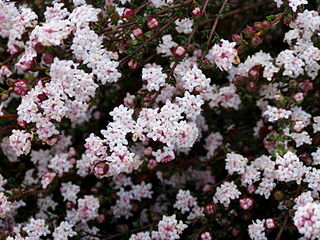
Pimelea brachyphylla is a species of flowering plant in the family Thymelaeaceae and is endemic to the south-west of Western Australia. It is an erect to spreading shrub with linear to elliptic leaves and clusters of white, tube-shaped flowers.

Grevillea eryngioides, commonly called curly grevillea, is a species of flowering plant in the family Proteaceae and is endemic to the south-west of Western Australia. It is shrub with low clumping foliage with erect flowering spikes, divided leaves with oblong to egg-shaped lobes, and groups of purplish-red flowers with a yellow style.
Olearia revoluta is a species of flowering plant in the family Asteraceae and is endemic to the south-west of Western Australia. It is an erect, rounded shrub with linear to oblong leaves with the edges rolled under, and white daisy-like inflorescences.

Leucopogon pendulus is a species of flowering plant in the heath family Ericaceae and is endemic to the south-west of Western Australia. It is an erect, straggling shrub with oblong leaves and white, tube-shaped flowers that are bearded inside.

Styphelia planifolia is a species of flowering plant in the heath family Ericaceae and is endemic to the south-west of Western Australia. It is a bushy shrub with narrowly oblong or lance-shaped leaves with a small, sharp point on the tip, and white, tube-shaped flowers.
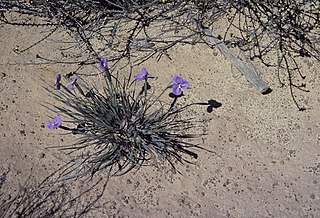
Patersonia drummondii, commonly known as Drummond's patersonia, is a species of plant in the iris family Iridaceae and is endemic to the south-west of Western Australia. It is a tufted herb with linear, often twisted leaves and pale violet to purple or blue tepals.
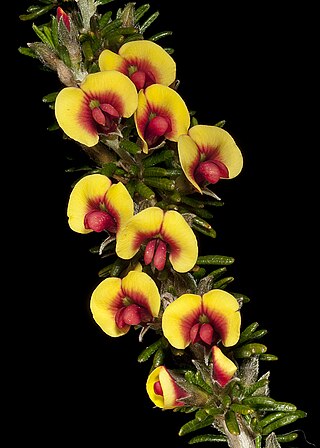
Mirbelia spinosa is a species of flowering plant in the family Fabaceae and is endemic to the south-west of Western Australia. It is a spiny shrub with narrowly linear leaves and yellow, orange and reddish-brown flowers.

Olearia muricata, commonly known as rough-leaved daisy bush, is a species of flowering plant in the family Asteraceae and is endemic to the south-west of Western Australia. It is an erect shrub with flat, linear to triangular leaves, and white or pale mauve and yellow, daisy-like inflorescences.

Sphaerolobium linophyllum is a species of flowering plant in the family Fabaceae and is endemic to the south of Western Australia. It is a prostrate to ascending shrub with a few narrowly linear leaves and red, yellow and orange flowers.
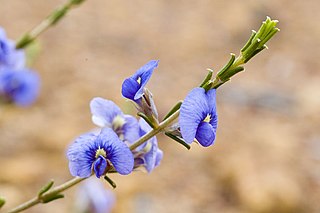
Mirbelia floribunda, commonly known as purple mirbelia, is a species of flowering plant in the family Fabaceae and is endemic to the south-west of Western Australia. It is an erect, slender or straggling, much-branched shrub with narrowly linear leaves and bluish-purple flowers.

Mirbelia multicaulis is a species of flowering plant in the family Fabaceae and is endemic to the south-west of Western Australia. It is an erect, rigid shrub that typically grows to a height of 15–50 cm (5.9–19.7 in) and has erect stems with few branches. It has scattered, egg-shaped to oblong leaves 4–6 mm (0.16–0.24 in) long and spines that are longer than the leaves. The flowers are arranged in clusters in leaf axils or at the base of the spines and are yellow or orange and reddish-brown and appear in September and October. It was first formally described in 1853 by Nikolai Turczaninow who gave it the name Dichosema multicaule in the Bulletin de la Société Impériale des Naturalistes de Moscou. In 1864, George Bentham changed the name to Mirbelia multicaulis in Flora Australiensis. The specific epithet (multicaulis) means "many stems".

Leucopogon concinnus is a species of flowering plant in the heath family Ericaceae and is endemic to the south-west of Western Australia. It is a low-lying shrub with many branches. Its leaves are egg-shaped or oblong, 2–4 mm (0.079–0.157 in) long with a small point on the end and the ends rolled under. The flowers are arranged singly or in pairs in leaf axils on a short peduncle. The sepals, petal tube and petal lobes are about 2 mm (0.079 in) long.
Cryptandra nutans is a species of flowering plant in the family Rhamnaceae and is endemic to the southwest of Western Australia. It is a shrub that typically grows to a height of 10–60 cm (3.9–23.6 in) and has many stems at ground level. Its leaves are up to 4 mm (0.16 in) long, and the flowers are white, pink or cream-coloured and crowded in spikes on the ends of branches. The sepals are joined at the base to form a broadly bell-shaped tube, less than 2 mm (0.079 in) long with spreading lobes. Flowering occurs in August and September. It was first formally described in 1845 by Ernst Gottlieb von Steudel in Lehmann's Plantae Preissianae from specimens collected in 1840. The specific epithet (nutans) means "nodding".

Conostephium preissii is a species of flowering plant in the family Ericaceae and is endemic to the southwest of Western Australia. It is an erect shrub with many stems, egg-shaped to oblong leaves and white and purplish to reddish-pink flowers.
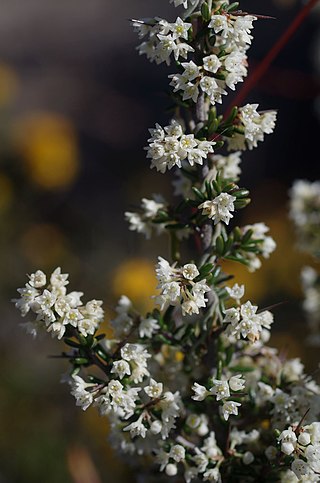
Cryptandra pungens is a species of flowering plant in the family Rhamnaceae and is endemic to the southwest of Western Australia. It is an erect, slender, spiny shrub that typically grows to a height of 0.2–1 m with many short branches ending with thin spines. Its leaves mostly in bundles and are 4–6 mm (0.16–0.24 in) long. The flowers are white, each on a pedicel 1–2 mm (0.039–0.079 in) long with minute, overlapping brown bracts at the base. The sepals are about 1.6 mm (0.063 in) long and joined at the base to form a broadly bell-shaped tube, with lobes half as long as the tube. Flowering occurs from May to November. The species was first formally described in 1845 by Ernst Gottlieb von Steudel in Lehmann's Plantae Preissianae from specimens collected in sandy forest near Perth. The specific epithet (pungens) means "ending in a sharp, hard point".

Guichenotia micrantha, commonly known as small flowered guichenotia, is a species of flowering plant in the family Malvaceae and is endemic to the south-west of Western Australia. It is a low, compact shrub with linear to narrowly egg-shaped leaves and pink flowers in groups of three to six.



















